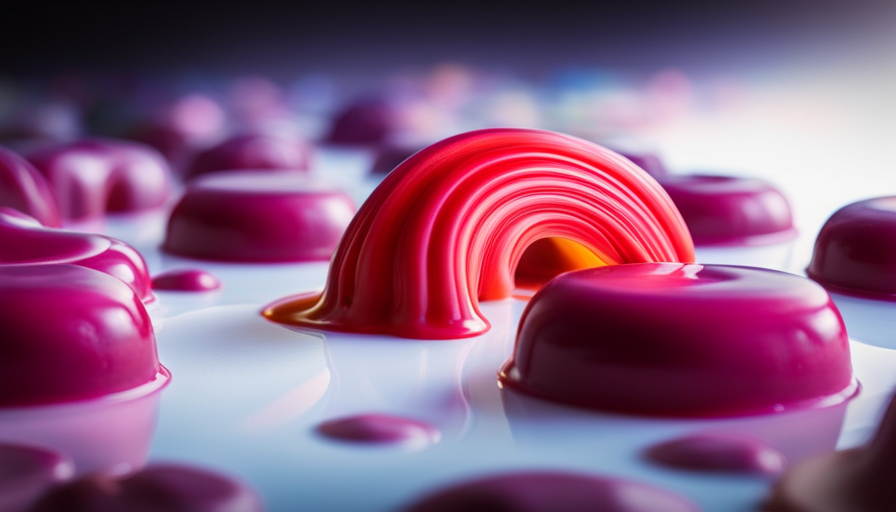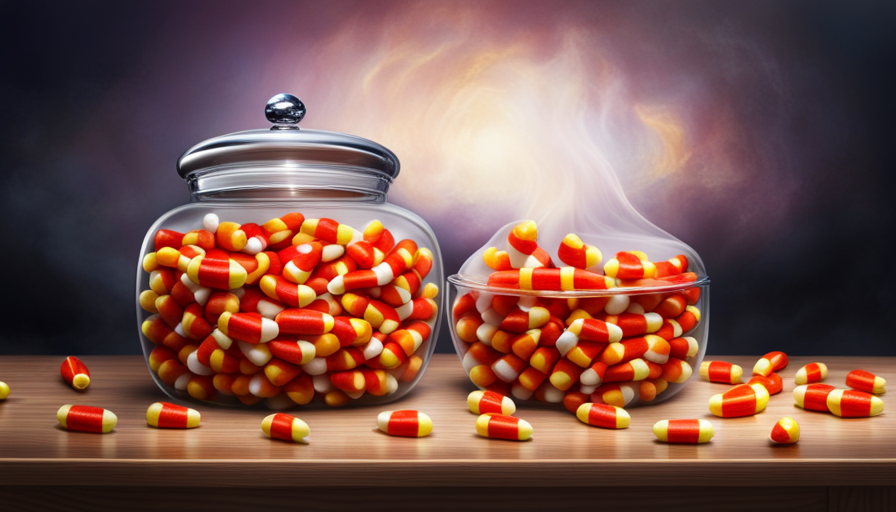Have you ever found yourself with a bowl of melted candy melts, wondering how long they will stay usable?
As a baking enthusiast, I know the frustration of not wanting to waste ingredients or create something that might not taste its best. That’s why understanding the shelf life of melted candy melts is crucial.
In this article, I will delve into the factors that affect the shelf life of melted candy melts, proper storage techniques, signs of spoilage, and creative ways to use leftovers. Additionally, I will provide expert tips and safety precautions to ensure a successful experience when working with melted candy melts.
So, whether you’re a novice baker or a seasoned pro, join me as we explore the fascinating world of melted candy melts and learn how to make the most out of this versatile ingredient.
Key Takeaways
- The quality of ingredients and melting temperature are important factors affecting the shelf life of melted candy melts.
- High-quality chocolate or candy melts can extend the shelf life of melted candy melts.
- Overheating can result in a grainy texture and negatively impact the shelf life of melted candy melts.
- Proper storage techniques, such as using airtight containers, keeping them in a cool and dry place, and avoiding sunlight and heat, can help maintain the freshness and quality of melted candy melts.
Factors that Affect the Shelf Life of Melted Candy Melts
You should be aware of the factors that can affect how long your melted candy melts will stay good. One of the main factors that determines the shelf life of melted candy melts is the quality of the ingredients used. Using high-quality chocolate or candy melts can significantly extend their shelf life.
Additionally, the temperature at which the candy melts are melted plays a crucial role. If the candy melts are overheated, they may lose their smooth texture and become grainy, affecting their shelf life. It’s important to use gentle melting techniques, such as using a double boiler or microwave in short intervals, to ensure that the candy melts are melted properly.
Another factor to consider is the humidity level in the storage area. High humidity can cause the candy melts to absorb moisture, resulting in a shorter shelf life. Properly storing melted candy melts in a cool, dry place, away from direct sunlight, can help maintain their quality for a longer period of time.
By understanding these shelf life factors and using appropriate melting techniques, you can ensure that your melted candy melts stay good for as long as possible, allowing you to enjoy them in various sweet treats.
How to Properly Store Melted Candy Melts
When storing melted candy melts, it’s important to use airtight containers to prevent moisture and air from affecting the quality and texture of the candy.
I recommend keeping the containers in a cool and dry place, as heat can cause the candy to melt again and lose its shape.
Additionally, it’s crucial to avoid exposing the melted candy melts to sunlight or any other sources of heat, as this can accelerate the melting process and affect the overall shelf life.
Use Airtight Containers
To maximize freshness, store your melted candy melts in airtight containers. This is an essential step in properly storing melted candy melts. Airtight containers provide a barrier against moisture, which is crucial in preventing the candy melts from becoming sticky or clumpy.
When moisture comes into contact with melted candy melts, it can cause them to lose their smooth consistency and become unusable. By using airtight containers, you can prolong the shelf life of your melted candy melts and ensure they stay in perfect condition for future use.
However, storing in airtight containers is just the first step. To further preserve the quality of your candy melts, it’s important to also keep them in a cool and dry place. This will help maintain their texture and prevent any unwanted changes.
Keep in a Cool and Dry Place
Storing your melted candy melts in a cool and dry place is crucial to maintaining their freshness and quality. To ensure you’re storing them properly, follow these steps:
-
Use airtight containers: This’ll prevent air and moisture from seeping into the candy melts, which can cause them to become stale or develop a grainy texture.
-
Store in the refrigerator: If you live in a hot and humid climate, it’s recommended to store your melted candy melts in the refrigerator. This’ll help prevent condensation buildup, which can lead to the candy melts losing their smooth texture.
-
Keep away from moisture: Moisture can cause the candy melts to seize or become clumpy. Make sure to keep them away from any sources of moisture, such as steam or water.
-
Avoid exposure to sunlight or heat: Sunlight and heat can cause the candy melts to melt further or become discolored. It’s best to store them in a cool and dry place, away from direct sunlight or heat sources.
By following these guidelines, you can ensure that your melted candy melts stay fresh and in optimal condition. Moving on to the next section, it’s important to also avoid exposure to sunlight or heat to further preserve their quality.
Avoid Exposure to Sunlight or Heat
Placing melted candy melts in direct sunlight or near a heat source risks ruining their smooth texture and vibrant colors. While this might seem obvious, it’s important to understand the reasons behind it.
Exposure to sunlight can cause the candy melts to melt further, resulting in a greasy texture and a loss of their original shape. Additionally, the vibrant colors can fade or even change completely due to the UV rays.
As for heat, it can have a similar effect, causing the candy melts to become too soft or even melt completely, resulting in a grainy texture. Different types of candies and chocolates may react differently to sunlight and heat, so it’s crucial to handle them with care.
Moving on to the next section about signs of spoiled melted candy melts, it’s important to be aware of certain indicators that can help identify whether the candy melts have gone bad.
Signs of Spoiled Melted Candy Melts
If you’re wondering how long your melted candy melts can stay good, it’s essential to know the signs of spoiled ones. Spoiled candy melts can pose health risks and ruin the taste of your creations. To ensure the quality and safety of your melted candy melts, it’s crucial to be aware of the following signs of spoilage:
-
Change in texture: Spoiled candy melts may become grainy or clumpy, indicating that they’ve lost their smooth and creamy consistency.
-
Off-putting odor: If your melted candy melts emit a strong or unpleasant smell, it’s a clear indication that they’ve gone bad.
-
Discoloration: Spoiled candy melts may develop an unusual color, such as darkening or fading, suggesting that they’re no longer suitable for use.
To prevent your melted candy melts from spoiling, proper storage is essential. Store them in an airtight container at room temperature, away from direct sunlight or heat sources. Additionally, avoid exposing them to moisture or humidity, as it can lead to mold growth.
Now that you know the signs of spoiled candy melts and the importance of proper storage, let’s move on to the next section about using melted candy melts in baking and decorating.
Using Melted Candy Melts in Baking and Decorating
Ready to take your baking and decorating skills to the next level? Let me show you how to use those deliciously melted candy melts in your creations! Candy melts are incredibly versatile and can be used in a variety of ways to enhance your desserts. One popular option is to use melted candy melts to coat cake pops. After shaping your cake pops, simply dip them into the melted candy melts and let them set. The candy coating adds a beautiful and tasty finish to your cake pops.
Another creative way to incorporate melted candy melts is by adding them to homemade ice cream. Once your ice cream base is ready, you can drizzle the melted candy melts into the mixture as it churns. This will create swirls of vibrant colors and a delightful flavor explosion in each bite.
To help you visualize the possibilities, here’s a handy table showcasing different ways to use melted candy melts in your baking and decorating:
| Dessert | Technique | Result |
|---|---|---|
| Cake Pops | Dip cake pops into melts | Beautifully coated pops |
| Ice Cream | Drizzle into churned base | Colorful and flavorful swirls |
| Cookies | Decorate with melted melts | Customized and eye-catching |
| Cupcakes | Pipe designs with melts | Fun and whimsical decorations |
| Brownies | Swirl melted melts | Marbled and visually appealing |
Now that you know how to use melted candy melts in your baking and decorating, let’s explore creative ways to use leftover melted candy melts without letting them go to waste.
Creative Ways to Use Leftover Melted Candy Melts
Let’s get creative with those melted candy melts and find exciting ways to repurpose them! When it comes to using melted candy melts, the possibilities are endless. Here are a few ideas to get you started:
-
Using melted candy melts in savory dishes: Don’t limit yourself to just sweet treats! Add a touch of sweetness to your favorite savory dishes by drizzling melted candy melts over grilled meats or roasted vegetables. The combination of flavors will surely be a hit.
-
Creating homemade candy bars: Why buy candy bars when you can make your own? Melted candy melts can be used as a base for creating delicious homemade candy bars. Simply mix in your favorite nuts, dried fruits, or other tasty additions, pour the mixture into a mold, and let it set. The result? A personalized candy bar that’s sure to satisfy your sweet tooth.
-
Making decorative cake toppers: Take your cake decorating skills to the next level by using melted candy melts to create intricate designs. Pour the melted candy into molds of various shapes and sizes, let them cool and harden, and then carefully remove them to use as unique cake toppers. Your desserts will instantly become the centerpiece of any occasion.
-
Designing edible art: Let your creativity shine by using melted candy melts as a medium for edible art. Use food coloring to create a rainbow of vibrant hues and then paint or drizzle the melted candy onto a canvas made of edible paper or wafer sheets. The result? A stunning masterpiece that looks almost too good to eat.
-
Making flavored hot chocolate: Add a burst of flavor to your hot chocolate by stirring in some melted candy melts. Whether you prefer classic flavors like chocolate or want to experiment with fruity or minty options, melted candy melts will take your hot cocoa game to a whole new level.
Now that you know some creative ways to use leftover melted candy melts, let’s move on to some tips for avoiding waste with these versatile treats.
Tips for Avoiding Waste with Melted Candy Melts
When it comes to avoiding waste with melted candy melts, there are a few key tips that I’ve found to be very helpful.
First, I always melt small batches at a time to prevent any excess from going to waste.
Secondly, I make use of silicone molds or piping bags to control the amount of candy melts I use for each project.
Finally, I plan ahead and save any leftover melted candy melts for future projects, ensuring that nothing goes to waste.
Melting Small Batches at a Time
If you’re wondering how long candy melts stay good once melted, here’s a tip for melting small batches at a time. When it comes to melting techniques, using a microwave or a double boiler are common methods. However, if you only need a small amount of melted candy, it’s best to melt it in the microwave. This allows for better control and avoids wasting excess candy. To melt small batches, simply place a handful of candy melts in a microwave-safe bowl. Heat them in 30-second intervals, stirring between each interval until fully melted. The table below summarizes the steps for melting small batches of candy melts in the microwave:
| Step | Instructions |
|---|---|
| 1 | Place a handful of candy melts in a microwave-safe bowl. |
| 2 | Heat in 30-second intervals. |
| 3 | Stir between each interval. |
| 4 | Repeat until fully melted. |
By using this method, you can ensure that your melted candy melts stay fresh and ready for use. Now, let’s move on to the next section about using silicone molds or piping bags.
Using Silicone Molds or Piping Bags
To maximize your options for creating unique candy shapes, try using silicone molds or piping bags.
When using silicone molds, simply pour your melted candy into the mold and allow it to set. This method allows for precise shapes and easy removal once the candy has hardened.
Piping bags, on the other hand, offer more flexibility and control over the design of your candies. You can create intricate patterns or fill molds with melted candy using different piping bag techniques. However, it’s important to troubleshoot common issues such as clogs or leaks in the piping bag to ensure smooth and consistent results.
By utilizing these techniques, you can create a wide variety of candy shapes and designs. Planning ahead and using leftovers in future projects is another way to minimize waste and maximize creativity.
Planning Ahead and Using Leftovers in Future Projects
After using silicone molds or piping bags to create beautiful candy melt designs, it’s important to plan ahead and make the most of any leftovers.
Melted candy melts can be used in a variety of ways beyond sweet treats. For example, you can incorporate them into savory dishes to add a unique touch of sweetness. They can be drizzled over roasted vegetables or used as a glaze for meats like ham or chicken.
Additionally, melted candy melts can be repurposed for crafts and DIY projects. They can be molded into decorative shapes or used as an adhesive for creating edible art. By thinking creatively, you can extend the lifespan of your melted candy melts and minimize waste.
Now, let’s move on to discuss safety precautions when working with melted candy melts.
Safety Precautions when Working with Melted Candy Melts
When working with melted candy melts, you should always prioritize safety precautions to ensure a smooth and worry-free experience. Here are some important safety measures to keep in mind:
| Safety Precautions | Common Mistakes |
|---|---|
| Always use oven mitts or heat-resistant gloves to protect your hands from burns. | Adding water or other liquids to melted candy melts, as it can cause the chocolate to seize and become lumpy. |
| Use a double boiler or microwave-safe bowl to melt the candy melts, avoiding direct heat contact. | Overheating the candy melts, as it can cause them to become scorched and unusable. |
| Stir the melted candy melts gently and consistently to avoid burning or clumping. | Using utensils or equipment with moisture, as even a small amount can cause the chocolate to seize. |
| Avoid overheating the candy melts by melting them in short intervals and stirring in between. | Not properly tempering the candy melts, leading to a dull and streaky appearance when they harden. |
Following these safety precautions will help you avoid common mistakes that can ruin your melted candy melts. Now, let’s move on to frequently asked questions about melted candy melts.
Frequently Asked Questions about Melted Candy Melts
Now that we’ve covered the safety precautions when working with melted candy melts, let’s move on to answering some frequently asked questions about this topic.
As someone who’s worked extensively with candy melts, I can provide you with valuable information on melting techniques and troubleshooting common issues.
When it comes to melting candy melts, there are a few different methods you can use. The most common technique is to melt them in the microwave, using short bursts of heat and stirring in between to ensure even melting. Another popular method is to use a double boiler setup, which involves placing the candy melts in a heatproof bowl over a pot of simmering water.
However, even with the right melting technique, you may encounter some common issues. For example, if your candy melts become too thick or clumpy, you can try adding a small amount of vegetable shortening or paramount crystals to thin them out. On the other hand, if your candy melts become too thin, you can try adding more candy melts or chilling them briefly in the refrigerator.
In the next section, we’ll dive into expert tips for using melted candy melts, where you’ll learn some invaluable tricks to enhance your candy-making skills.
Expert Tips for Using Melted Candy Melts
When using melted candy melts, there are several expert tips that can enhance your experience.
One tip is to use candy melts as a substitute for other ingredients, such as chocolate chips or frosting, to add a unique flavor and texture to your baked goods.
Another tip is to mix different colors of candy melts together to create custom shades for your creations.
Lastly, don’t be afraid to experiment with different flavors and add-ins, like extracts or crushed cookies, to make your melted candy melts even more delicious and unique.
Using Candy Melts as a Substitute for Other Ingredients
Using candy melts as a substitute for other ingredients will definitely add a delightful twist to your recipes! Here are three ways you can incorporate candy melts into your savory dishes:
-
Create a sweet glaze: Melted candy melts can be used to make a delicious glaze for meats like ham or chicken. The sweet and savory combination will add a unique flavor to your dish.
-
Add a touch of sweetness to sauces: Candy melts can be melted and added to savory sauces like barbecue or teriyaki. This’ll give your sauce a hint of sweetness without overpowering the other flavors.
-
Boost the health benefits: Candy melts’re made with cocoa butter, which’s rich in antioxidants. By using candy melts in your savory dishes, you can enhance the nutritional value of your meal.
Using candy melts as a substitute for other ingredients opens up a world of possibilities in the kitchen. Now, let’s explore how mixing colors can help create custom shades for your creations.
Mixing Colors to Create Custom Shades
To achieve the perfect hue for your culinary masterpiece, get ready to mix and mingle a palette of vibrant colors with your candy melts! Creating custom color combinations with candy melts opens up a world of possibilities for your desserts.
By blending different colored melts, you can achieve stunning gradient effects that will surely impress your guests. Start by melting your desired colors separately, then slowly mix them together using a toothpick or small spatula. Remember to work quickly, as candy melts can harden fast.
Experiment with different ratios and blending techniques to find the perfect shade for your creation. Once you’ve achieved your desired color, you can seamlessly transition into the subsequent section about experimenting with different flavors and add-ins.
Experimenting with Different Flavors and Add-Ins
Get ready to take your desserts to the next level with a variety of exciting flavors and add-ins! Experimenting with different flavors and add-ins can create unique and delicious candy melt treats. By combining different flavors, you can create flavor combinations that are sure to impress.
Try mixing in extracts like vanilla, almond, or mint to add a burst of flavor. You can also incorporate add-ins like crushed cookies, chopped nuts, or dried fruit for added texture and crunch. These additions not only enhance the taste but also create texture variations that make each bite interesting.
So, whether you’re looking for a classic combination or want to get creative with unexpected flavors, there are endless possibilities to explore with candy melts.
In the next section, we’ll explore the conclusion and final thoughts on how to make the most of your candy melt creations.
Conclusion and Final Thoughts
When you’re ready to wrap up, take a moment to reflect on your findings and let the captivating images of your investigation linger in the minds of your audience. Experimenting with different flavors and add-ins has opened up a whole new world of possibilities for using melted candy melts in savory dishes and incorporating them into cocktails.
Here are three key takeaways from this exploration:
-
Unexpected savory delights: By melting candy melts and incorporating them into savory dishes, you can create unique flavor combinations. For example, a touch of melted caramel candy melts can add a sweet and savory twist to a traditional pasta dish or a glaze for roasted vegetables.
-
Creative cocktail concoctions: Melted candy melts can also be a game-changer in the world of cocktails. By infusing them into syrups or using them as garnishes, you can add a burst of flavor and visual appeal to your drinks. From chocolate-infused martinis to candy melt rimmed margaritas, the possibilities are endless.
-
Experimentation is key: Don’t be afraid to get creative and think outside the box when it comes to using melted candy melts. The only way to discover unexpected flavor combinations is by experimenting and pushing the boundaries. So, let your imagination run wild and see where it takes you.
Incorporating melted candy melts into savory dishes and cocktails can elevate your culinary creations to new heights. So go ahead, unleash your inner chef and mixologist, and let the magic of melted candy melts transform your next culinary adventure.
Frequently Asked Questions
Can melted candy melts be re-melted if they harden?
Yes, melted candy melts can be re-melted if they harden. To re-melt hardened candy melts, simply place them in a microwave-safe bowl and heat in short intervals, stirring in between, until they become smooth and pourable again.
To prevent candy melts from hardening, it’s recommended to melt them in a double boiler or using a microwave at low power, while continuously stirring. Adding a small amount of vegetable shortening can also help maintain a smoother consistency.
Are there any health risks associated with consuming melted candy melts?
There are no significant health risks associated with consuming melted candy melts. However, it’s important to note that they aren’t known for their health benefits or nutritional value. Candy melts are primarily used for decorative purposes in baking and confectionery. While they may contain some ingredients that provide flavor, they aren’t a source of essential nutrients.
It’s always important to consume treats like candy melts in moderation as part of a balanced diet.
Can melted candy melts be used as a substitute for chocolate in recipes?
Melted candy melts can be used as a substitute for chocolate in recipes, but there are a few differences to consider. Candy melts are smoother and have a more intense flavor compared to chocolate chips. To properly melt candy melts, use a microwave or double boiler method, being careful not to overheat them. Stir them frequently until smooth and then they can be used in various recipes as a substitute for chocolate.
What is the best method for reheating melted candy melts?
The best method for reheating melted candy melts is to use a microwave or a double boiler. To prevent scorching or seizing, it’s important to heat the candy melts slowly and stir frequently.
When using a microwave, heat the melted candy melts in short intervals, stirring in between, until they reach the desired consistency.
In a double boiler, place the melted candy melts over simmering water and stir until smooth.
These tips will help you achieve a smooth and reheat your candy melts effectively.
How long can melted candy melts be stored before they start to lose their flavor?
The shelf life of melted candy melts, before flavor degradation becomes noticeable, is approximately two weeks when stored properly. It’s important to keep them in an airtight container at room temperature, away from direct sunlight and moisture.
After this time, the flavor may start to diminish, affecting the overall taste. To ensure the best flavor, it’s recommended to consume the melted candy melts within this two-week period.
Conclusion
In conclusion, the shelf life of melted candy melts can vary depending on several factors. Proper storage is essential to maintain their quality and prevent spoilage. Remember to look out for signs of spoilage, such as an off smell or mold growth.
Melted candy melts can be used in various baking and decorating projects, and there are also creative ways to repurpose any leftovers. Always prioritize safety when working with melted candy melts. Follow these expert tips for a successful candy melting experience.










